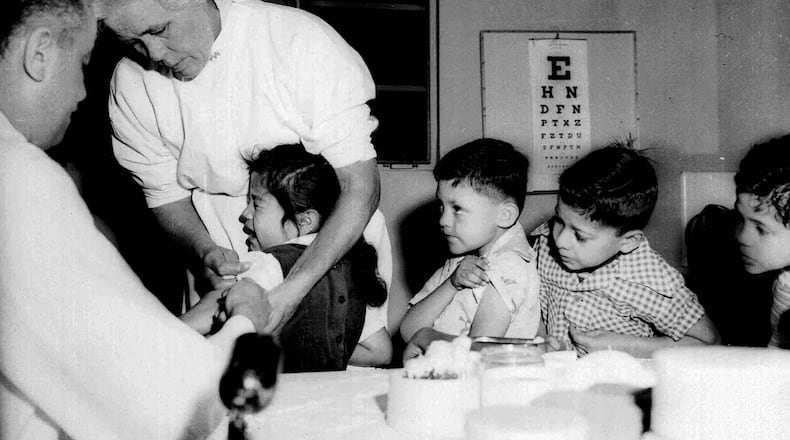The surprising discovery in New York of circulating poliovirus – the dreaded killer and crippler of thousands of American children in the 1940s and 1950s – has Georgia health experts urging parents to get their children vaccinated.
While most don’t think the single New York case of a young, unvaccinated man and subsequent surveillance findings foreshadow widespread cases, they say it is a wake-up call, especially in the days of COVID-19, which is seeing a general decline in immunization rates.
“We all have to be really careful that we get our children vaccinated,” said Dr. Joanna Dolgoff, a Paulding County pediatrician. “If we let our immunization rates drop, we will see some of these old diseases come back.”
For polio protection, Georgia children born in 2018 are behind their young peers around the country: 91.4% have had three or more doses of polio vaccine, compared with 94.8% nationally, according to the Centers for Disease Control and Prevention’s National Immunization survey. The analysis looked at the immunization rate at 35 months, just shy of three years old.
Even a 1% dip in immunizations can translate into thousands of fewer vaccinated Georgia children, according to Dr. Angela Highbaugh-Battle, who practices in St. Marys and is president of the Georgia chapter of the American Academy of Pediatrics. Experts say immunization rates have dipped over recent years especially during the COVID-19 pandemic, largely because of anti-vaccine sentiment.
Polio is a very contagious virus that is mainly spread by contact with the feces of an infected person, usually through poor handwashing or from eating or drinking contaminated food or water. Less commonly, polio can spread from the sneeze or cough of an infected person, according to the CDC.
Patients infected with the polio virus can pass the virus on for 7–10 days before the onset of the disease. In addition, they can continue to shed the virus in their stool for three to six weeks. There is no cure for the disease.
Seventy years ago, polio was one of the most feared diseases in the U.S., killing thousands of American children each summer and paralyzing many more. Public swimming pools, bowling alleys, and movie theaters were shuttered. Iron lung machines lined hospital wards to help keep polio patients alive.
Then, in the mid-1950s, a polio vaccine was developed and mass vaccinations were under way. By 1979, the United States was declared polio-free. It has long been forgotten in many parts of the world.
But in a surprising twist, the New York case shows that polio is back, now circulating in this country. Polio experts, like Dr. Yvonne Maldonado of Stanford University, believe more cases are possible.
“We know there’s a lot of unvaccinated children in some of these communities and we know the virus is in the water so we are just holding our breath waiting to see if another case might show up,” Maldonado said. She said the anti-vaccine sentiment that grew during the pandemic has had a “downstream impact on attitudes toward routine childhood vaccinations.”
New York officials recently reported a case of polio in a young unvaccinated man, the first case in the U.S. in nearly a decade. Wastewater surveillance shows the virus circulating not only in Rockland County, N.Y., where the man lives, but also in New York City.
Polio may have been circulating widely for several months and was present in New York’s wastewater as early as April, according to a new report from the CDC.
New York health officials confirmed that the man’s infection was transmitted by someone who received the oral polio vaccine, which has not been administered in the United States since 2000. Children in the U.S are immunized with an inactivated polio vaccine injected in the arm or leg. People who have received three doses of the inactivated polio vaccine are well protected against the virus, but the virus poses a potential danger to unvaccinated people.
The New York man, who is 20 years old, suffered paralysis, health officials said. Had he been vaccinated, they said he would not have gotten polio.
The oral vaccine, used in several countries, is considered safe and effective, but people who receive it can shed the weakened virus in their stool for weeks, and potentially - albeit in rare instances - infect others.
Wastewater testing has so far identified only vaccine-derived viruses, not the “wild” poliovirus that circulates naturally in the environment. Maldonado, professor of global health and infectious diseases at Stanford, said it was very likely to have been imported in asymptomatic people infected by the live vaccine virus in a country where that type of vaccine is still used.
There is a small possibility that these vaccine-derived polioviruses could be found in wastewater in some U.S. communities, said Maldonado, who has focused on polio vaccines and eradicating the disease globally for more than 25 years.
Credit: AP
Credit: AP
Maldonado said the New York case is “concerning,” but added “I don’t think there’s a rush to panic here. At the same time, I think what it does tells us is we are seeing the emergence of an infectious disease that is entirely preventable.”
“It could absolutely happen again. We know there’s a lot of unvaccinated children in some of these communities and we know the virus is in the water so we are just holding our breath waiting to see if another case might show up.”
Highbaugh-Battle urges parents to get their children vaccinated:
“I am encouraging you to please, please, please have your children vaccinated and get them vaccinated on time. That is the number one thing we can do to prevent polio.”
She said she’s thrilled she’s never seen a case of polio. And she wants it to stay that way.
— Data specialist Jennifer Peebles contributed to this article.
About the Author
The Latest
Featured




